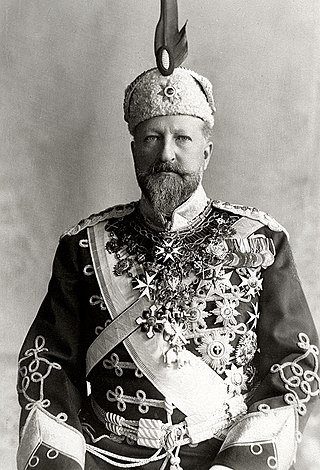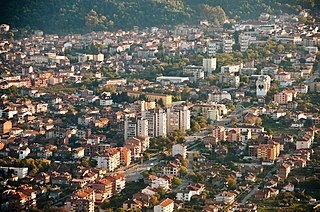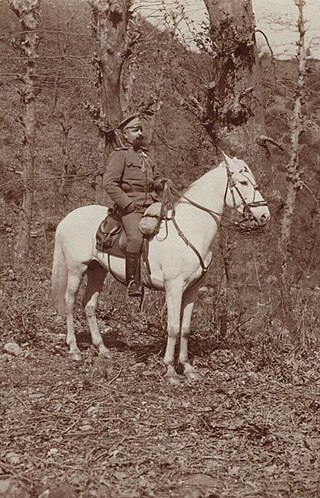| |||||
| Decades: | |||||
|---|---|---|---|---|---|
| See also: | |||||
Events in the year 1925 in Bulgaria .
| |||||
| Decades: | |||||
|---|---|---|---|---|---|
| See also: | |||||
Events in the year 1925 in Bulgaria .

Boris III, originally Boris Klemens Robert Maria Pius Ludwig Stanislaus Xaver, was the Tsar of the Kingdom of Bulgaria from 1918 until his death in 1943.

Ferdinand , born Ferdinand Maximilian Karl Leopold Maria of Saxe-Coburg and Gotha, was the second monarch of the Third Bulgarian State, firstly as ruling prince (knyaz) from 1887 to 1908, and later as king (tsar) from 1908 until his abdication in 1918. Under his rule Bulgaria entered the First World War on the side of the Central Powers in 1915.

The Internal Macedonian Revolutionary Organization, was a secret revolutionary society founded in the Ottoman territories in Europe, that operated in the late 19th and early 20th centuries.

Petrich is a town in Blagoevgrad Province in southwestern Bulgaria, located in Sandanski–Petrich Valley at the foot of the Belasica Mountains in the Strumeshnitsa Valley. According to the 2021 census, the town has 26,778 inhabitants.

Princess Maria Luisa of Bourbon-Parma was the eldest daughter of Robert I, the last reigning Duke of Parma. She became Princess of Bulgaria upon her marriage to Ferdinand I, the then prince-regnant. She was the mother of Tsar Boris III of Bulgaria.

The Tsardom of Bulgaria, also referred to as the Third Bulgarian Tsardom, sometimes translated in English as the "Kingdom of Bulgaria", was a constitutional monarchy in Southeastern Europe, which was established on 5 October 1908, when the Bulgarian state was raised from a principality to a tsardom.

Aleksandar Tsolov Tsankov was a leading Bulgarian politician during the interwar period between the two world wars.

The history of Bulgaria during World War II encompasses an initial period of neutrality until 1 March 1941, a period of alliance with the Axis Powers until 8 September 1944, and a period of alignment with the Allies in the final year of the war. Bulgarian military forces occupied with German consent parts of the Kingdoms of Greece and Yugoslavia which Bulgarian irredentism claimed on the basis of the 1878 Treaty of San Stefano. Bulgaria resisted Axis pressure to join the war against the Soviet Union, which began on 22 June 1941, but did declare war on Britain and the United States on 13 December 1941. The Red Army entered Bulgaria on 8 September 1944; Bulgaria declared war on Germany the next day.

Sveta Nedelya Cathedral Church, is an Eastern Orthodox cathedral in Sofia, the capital of Bulgaria, a cathedral of the Sofia bishopric of the Bulgarian Patriarchate. The temple of Sveta Nedelya dates back to the 10th century, being a cathedral of the city from the 18th century. The sacred building has suffered destruction through the ages and has been reconstructed many times. The present building of the temple is among the landmarks of Sofia. It was designed by the famous Bulgarian architectural team Vasilyov-Tsolov. The relics of the Serbian king Stefan Uroš II Milutin are kept in the church.

The St Nedelya Church assault was a terrorist attack on St Nedelya Church in Sofia, Bulgaria. It was carried out on 16 April 1925, when a group of the Military Organisation of the Bulgarian Communist Party directed and supplied by the Soviet Military Intelligence blew up the church's roof during the funeral service of General Konstantin Georgiev, who had been killed in a previous communist assault on 14 April. 150 people, mainly from the country's political and military elite, were killed in the attack and around 500 bystander believers, who attended the liturgy, were injured.

The last Bulgarian royal family is a line of the Koháry branch of the House of Saxe-Coburg and Gotha, which ruled Bulgaria from 1887 to 1946. The last tsar, Simeon II, became Prime Minister of Bulgaria in 2001 and remained in office until 2005. Members of the royal family claim the titles of Prince (Princess) of Bulgaria and Duke (Duchess) in Saxony, with the style of Royal Highness.

The 1923 Bulgarian coup d'état, also known as the 9 June coup d'état, was a coup d'état in Bulgaria implemented by armed forces under General Ivan Valkov's Military League on the evening of 9 June 1923. Hestitantly legitimized by a decree of Tsar Boris III of Bulgaria, the coup overthrew the elected government headed by Aleksandar Stamboliyski of the Bulgarian Agrarian National Union, and replaced it with one under Aleksandar Tsankov.

Alexandar Protogerov was a Bulgarian general, politician and revolutionary, as well as a member of the revolutionary movement in Macedonia, Thrace and Pomoravlje. Protogerov was a Bulgarian Freemason and held a leading position in the lodge where he was a member.

The Incident at Petrich, or the War of the Stray Dog, was a Greek–Bulgarian crisis in 1925 that resulted in a brief invasion of Bulgaria by Greece near the border town of Petrich after the killing of a Greek captain and a sentry by Bulgarian soldiers.
The following events occurred in April 1925:
The following events occurred in October 1925:

Lev Nikolov Glavinchev was a Bulgarian communist, officer (colonel) and politician. Glavinchev was a member of the Internal Macedonian Revolutionary Organization, and one of the most controversial personalities in the Macedonian freedom movement. An active participant in the communist partisan movement during the Second World War, he was also a commander of the First Sofian Revolutionary Operative Zone of the National Freedom Revolutionary Army (NOVA). As commendant of the People's Militsiya after the 1944 coup d'état, he personally, willingly and methodically killed officers, intellectuals and public figures.

Krystju Christ Zlatarev was a Bulgarian officer, and commanded the 11th Macedonian Infantry Division throughout World War I.
Events in the year 1928 in Bulgaria.
Events in the year 1924 in Bulgaria.
{{cite book}}: CS1 maint: location missing publisher (link)